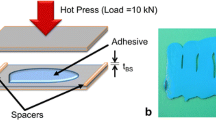Abstract
A study was made of the fatigue behavior of three types of 2024-T3 aluminum-alloy adhesive-bonded joints: single-lap joint, scarf joint and butt joint bonded with two kinds of adhesives, a vinyl-phenolic type, FM-47 and a nitride rubber-phenolic type, Metlbond 4021.
Two different modes of fatigue failures of the single-lap joints, i.e., sheet-metal failure and adhesive-bonding failure, were caused by the different stress components in the joint. The influence of the variations of stress distribution caused by the difference in mechanical properties of the adhesive, geometry of the joints, and the type of loading on fatigue strength of the adhesive-bonded joints, were analyzed.
Similar content being viewed by others
Abbreviations
- σ:
-
normal stress, psi
- τ:
-
shear stress in adhesive layer, psi
- P :
-
nominal axial stress in the sheet, psi
- F :
-
axial load, lb
- C :
-
one-half length of overlap, in.
- X :
-
distance from center of overlap, in.
- t :
-
thickness of sheet metal, in.
- Z :
-
distance from center of sheet thickness, in.
- W :
-
width of sheet metal, in.
- η:
-
thickness of adhesive layer
- K :
-
moment factor in dimensionless unit
- E :
-
elastic modulus of sheet metal, psi
- E a :
-
elastic modulus of adhesive, psi
- G a :
-
shear modulus of adhesive, psi
- β:
-
(8G at /E η )1/2
- δ:
-
(6E at /E η )1/2
- γ:
-
δC/t
References
Schliekelmann, R. J., and Cools, J., “Fatigue Properties of Reduxbonded Lapjoints of 24 ST Alclad,” Report Nr. R-26, Fokker Aircraft Co., October 1952.
Benson, N. K., “The Mechanics of Adhesive Bonding,”Appl. Mech. Rev., 14 (2),pp. 83–87 (February 1961).
Goland, M., andReissner, E., “The Stresses in Cemented Joints,”ASME Trans., 66, pp. A17-A27 (1944).
Author information
Authors and Affiliations
Rights and permissions
About this article
Cite this article
Wang, D.Y. Influence of stress distribution on fatigue strength of adhesive-bonded joints. Experimental Mechanics 4, 173–181 (1964). https://doi.org/10.1007/BF02329635
Issue Date:
DOI: https://doi.org/10.1007/BF02329635




